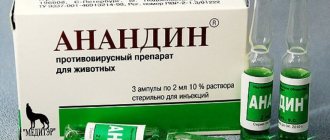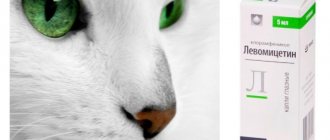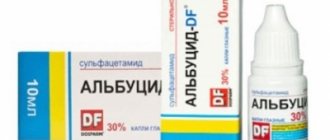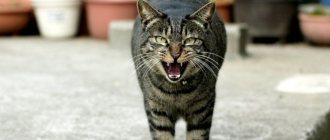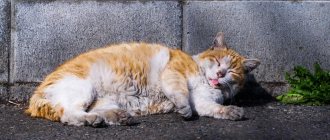Eye drops for cats: indications
The prescriptions for the use of various eye drops in cats are similar, so it is possible to generalize the recommendations for their use.
Anandin for cats
The medicine is prescribed in this form in the following cases:
- infected injuries of the organs of vision (in complex treatment);
- preparing a cat for ophthalmic surgery;
- prevention of complications after eye surgery;
- conjunctivitis of various natures and forms;
- keratitis;
- blepharitis;
- inflammatory processes in the nasolacrimal ducts.
The manifestations of many eye pathologies in cats are similar, which is why trying to self-medicate is quite dangerous. In case of severe lesions, drops are used only in complex therapy in parallel with antibiotic injections.
Kinds
Ophthalmic drugs are usually classified according to their mechanism of action into:
- antiseptic;
- antihistamines;
- preventive;
- metabolic (corneoprotectors);
- treatment and prophylactic;
- moisturizing.
Thus, ophthalmic veterinary drugs can have: anti-inflammatory, antibacterial, decongestant, antiseptic effects. Depending on their chemical composition, they are prescribed for both treatment and preventive purposes to reduce the risk of developing eye diseases in cats. They have a quick local effect.
recommended articles:
- Why does a cat squint one eye?
- Changes in eye color in cats
How to put drops in a cat's eyes
Ophthalmic drops for cats are prescribed for the treatment of:
- acute, subacute, chronic purulent, catarrhal, serous, allergic conjunctivitis;
- keratoconjunctivitis;
- cataracts, glaucoma;
- uveitis;
- corneal ulcers;
- blepharitis;
- septic iridocyclitis;
- inversion of the eyelids;
- eye diseases of infectious nature.
Important! If conjunctivitis is caused by chlamydial infection, toxoplasmosis, rhinotrachitis, calcivirosis, or other bacterial and viral diseases, in addition to eye drops, symptomatic therapy using antibacterial medications is prescribed.
Antiseptic eye drops are prescribed for ophthalmic ailments of an infectious, viral, or bacterial nature. Used to treat purulent and inflammatory processes. The active substances of the drugs have a detrimental effect on pathogenic flora and normalize the physiological balance in various structures of the eye.
Antihistamine drops are prescribed for swelling, redness, pain, as well as for eye injury from foreign objects. Veterinary medications reduce the impact of allergens that provoke allergic conjunctivitis. The symptoms of allergic manifestations are quickly relieved.
Metabolic drugs normalize visual function, improve metabolic processes in the cellular structures of eye tissue, and accelerate the process of epithelialization and recovery. Prescribed to eliminate destructive and degenerative processes in the cornea.
Moisturizing ophthalmic drops eliminate corneal dryness, relieve redness, increase the stability of the tear film, and increase the volume of tear fluid.
Directions for use: how to instill eye drops into a cat
For an animal, the number of instillations per day depends on the prescribed drug, general condition and the instructions of the veterinarian.
The method by which the composition is administered is the same for all types of eye drops. Before instillation, the eyes are washed using a furatsilin solution, a special lotion or saline solution.
A drop of the composition is instilled into each eye of the cat under the lower eyelid.
Ciprovet for cats
A large dosage is not required, as the product will flow out. If the animal responds calmly to treatment, then the bottle can be presented from any side. For cautious pets who are afraid of manipulation, the drops are brought to the eye from the back of the head so that they cannot see anything and become nervous.
When treating an aggressive animal, it is advisable to perform procedures with an assistant. The cat is wrapped in a thick blanket or tucked into the sleeve of a jacket.
While one person is holding the animal, the second is burying it. If the cat categorically does not allow eye drops, you should consult a veterinarian, since there is a high probability that the pet simply cannot tolerate the prescribed drug.
Be sure to read:
Can cats be given analgin and in what dosage, analogues of the drug
Antiseptic
Drops of this group are used for eye diseases caused by bacteria or fungus. They are obtained on the basis of substances of chemical origin that have a disinfecting effect. Antiseptics are effective against most pathogens of conjunctivitis and blepharitis; the resistance of microorganisms to such agents is very low. The most effective and safe in veterinary medicine are:
- Lacrican.
The active ingredients are antiseptic polysept, anesthesin and menthol. These eye drops have an antimicrobial and anesthetic effect and are indicated for acute and chronic infectious conjunctivitis and blepharitis in cats. The price of a 10 ml bottle is about 100 rubles. - Lakrimin aseptic.
Active ingredients: chloramphenicol and sodium sulfosalicylate. Used for the treatment of catarrhal, purulent, follicular blepharitis and conjunctivitis, as well as for the development of postoperative complications. The packaging of the drug (10 ml plastic bottle) costs 250 rubles. - Barrier.
Ophthalmic drug based on the antiseptic decamethoxin. It has excellent anti-inflammatory and antiallergic properties, is active against gram-positive and gram-negative microorganisms. Packaging: 10 ml bottles with a dropper cap, price - 35-40 rubles. - Ophthalmosan.
A complex preparation that includes: antiseptic chlorhexidine bigluconate, extracts of medicinal herbs (chamomile, calendula, eyebright), succinic acid, which has a local immunostimulating effect.
For cats, Oftalmosan drops are used as a means of preventing and treating eye diseases of bacterial etiology, and are also used for hygienic treatment of eyes for tearing. The price of a 15 ml bottle is 250 rubles.
- Diamond eyes.
The active ingredients are the antiseptic chlorhexidine bigluconate and the cell repair (restoration) stimulator taurine. The drug has good antiseptic, anti-inflammatory, anti-edematous and regenerating effects. Packaging price (plastic pipette bottle with a capacity of 10 ml) - 200 rubles.
What eye diseases are common in cats?
The main eye pathologies in cats are:
- Conjunctivitis - when the disease occurs, inflammation of the mucous membrane of the eyelids occurs. The reasons for the development of the disease are varied - from dirt getting into the eye to infection.
- Keratitis is an inflammation of the cornea in cats that usually also affects the eyelids.
- Blepharitis is an inflammation of the eyelids, which may be accompanied by the formation of ulcers.
- Cataracts are similar to this disease in humans and are treated with surgery.
Other pathologies of the visual organs in cats are rarely observed. Injuries to the eyeball more often occur in pets that have free access to the street.
Antibacterial
These semi-synthetic ophthalmic agents are obtained from substances produced by molds, bacteria and actinomycetes - microorganisms that combine the properties of bacteria and fungi. Antibiotic eye drops prevent the growth and reproduction of pathogenic bacteria.
The best representatives of the group:
- Leopard
is a complex product that contains the antibiotic chloramphenicol (chloramphenicol) and the antiseptic furatsilin (nitrofural). Application: inflammatory eye diseases caused by bacterial infection, eye injuries. The price of a standard package of Bars eye drops (10 ml) is 196 rubles. - Tsiprovet.
A drug from the fluoroquinolone group, the active substance is ciprofloxacin hydrochloride, which has a bactericidal and anti-inflammatory effect. Tsiprovet is active against most microorganisms, including mycoplasmas, chlamydia, staphylococci and Pseudomonas aeruginosa. According to the instructions, the drug is also used as a means of preventing infections in the postoperative period. Price 10 ml - 154 rub. - Iris.
Eye drops based on the antibiotic gentamicin. Used in the treatment of infectious blepharitis, corneal ulcers, keratitis and conjunctivitis. When prescribing the drug, it should be taken into account that anaerobic bacteria and protozoa are not sensitive to gentamicin. The cost of a bottle of drops (10 ml) is about 170 rubles. - Dekta-2.
A drug based on the broad-spectrum antibiotic Gentamicin and the antihistamine glucocorticosteroid Dexamethasone. Prescribed for eye diseases of bacterial and allergic origin. Contraindications for use are ulcers and erosions of the cornea of the eyes. A 5 ml bottle costs 132 rubles. - Tobrex
. The active substance is an antibiotic of the aminoglycoside group Tobramycin. In veterinary medicine, Tobrex is considered one of the fastest-acting bactericidal agents in the treatment of infectious eye diseases. A dropper bottle with a dispenser (30 ml) costs 180 rubles. - Levomycetin (Chloramphenicol).
A broad-spectrum antibacterial agent, effective for catarrhal and purulent conjunctivitis, blepharitis, keratitis, as a means of treating infected eye wounds and preventing postoperative complications. Available in 10 ml bottles, the cost of the bottle is 10-15 rubles.
You can now see the current price of eye drops for cats and buy them right here:
All antibacterial agents act selectively on certain types of infectious agents. Therefore, they should be prescribed by a doctor, taking into account the results of laboratory diagnostics.
How to put a solution in your eyes
Drops on the withers for cats against fleas, ticks and worms
In order to comfortably administer eye drops for cats at home, you should position your pet correctly. You can do this in several ways:
If a person is alone and there is no one to help him, then you need to lightly press the cat to the floor. Cover your head with one hand, placing four fingers under your lower jaw. And with your thumb placed on the area of the upper eyelid, pull it up. With your other hand, add the required number of drops.
If there is someone to help, then you should put the cat on its back. In this case, one person will hold the animal’s paws. And the second, holding it by the muzzle, pulls the eyelid and drips drops. Only in this case is it convenient to pull back the eyelid with your index finger and place your thumb under the lower jaw.
How to put eye drops
How to use eye drops
Before the procedure, the cat’s eyes should be cleaned; if mucus or pus has accumulated in them, it should be carefully removed with a damp cotton pad. You should wipe the eye in the direction from the outer corner to the nose. The medicine is applied under the slightly retracted lower eyelid; the number of drops and frequency of use of the medicine are determined by the instructions.
When treating ophthalmic diseases in cats, you should not allow the animal to rub the sore eye with its paw, and your pet will certainly try to do this. Therefore, the cat will have to wear a protective collar throughout the therapy, the design of which allows it to see and eat normally. You should buy a collar of such a size that it does not put pressure on the animal’s throat, but also does not hang around the neck.
Cat eye drops
Pharmaceutical companies have developed many different medications for cats to treat eye diseases. There is a wide range of eye drops available on the market. Some owners prescribe such drugs to their pets on their own. But this is not recommended.
Only a veterinarian should prescribe drops after diagnosing and making an accurate diagnosis.
But the pet owner still has to understand what medications exist.
The most commonly used cat eye drops are listed below:
- Leopard. Intended for the treatment of keratitis, purulent conjunctivitis and other infections. The product contains novocaine and furatsilin. The first component has an analgesic effect, the second – disinfects. You can also use such drops for preventive purposes. Suitable for all cat breeds.
- Diamond eyes. Drops for cats Diamond Eyes have an antibacterial effect and cope well with inflammation. The main component of the product is chlorhexidine. Also contains succinic acid and taurine. Veterinarians prescribe this drug to treat various diseases. The product is usually applied to a gauze swab and used to remove purulent discharge and scabs.
- Levomycetin. The drug is characterized by antibacterial properties. Quite effective drops in the treatment of conjunctivitis.
- Iris. Iris eye drops for cats are effective in the treatment of conjunctivitis, both acute and chronic. They also help with corneal erosions, keratitis, uveitis, and blepharitis. Prescribed not only for treatment, but also for preventive purposes. The drug contains gentamicin sulfate and a number of auxiliary components. The product has a pronounced anti-inflammatory and antibacterial effect. Drops for cats Iris are sold at any veterinary pharmacy.
- Tsiprovet. This is a product that contains the powerful antibiotic ciprofloxacin. The drug has a wide spectrum of action. Ciprovet helps to cope with bacteria such as Staphylococcus aureus, chlamydia, Pseudomonas aeruginosa. It is also effective against coccal infections. This remedy can also be used to treat kittens.
Rules of application
Rules of use and recommended dosages are contained in the instructions for each drug for the treatment of eye diseases in cats. There are also general recommendations that must be followed when trying to help your pet on your own:
- before using the drug, you need to make sure that it is intended for animals and has antibacterial properties, and its shelf life has not yet expired;
- Before putting drops into the cat’s eyes, you need to use a swab moistened with warm water to remove crusts and accumulations of mucus on the eyelids and around;
- make sure that the animal is securely restrained and does not jerk its head, causing injury to itself on the dropper spout.
